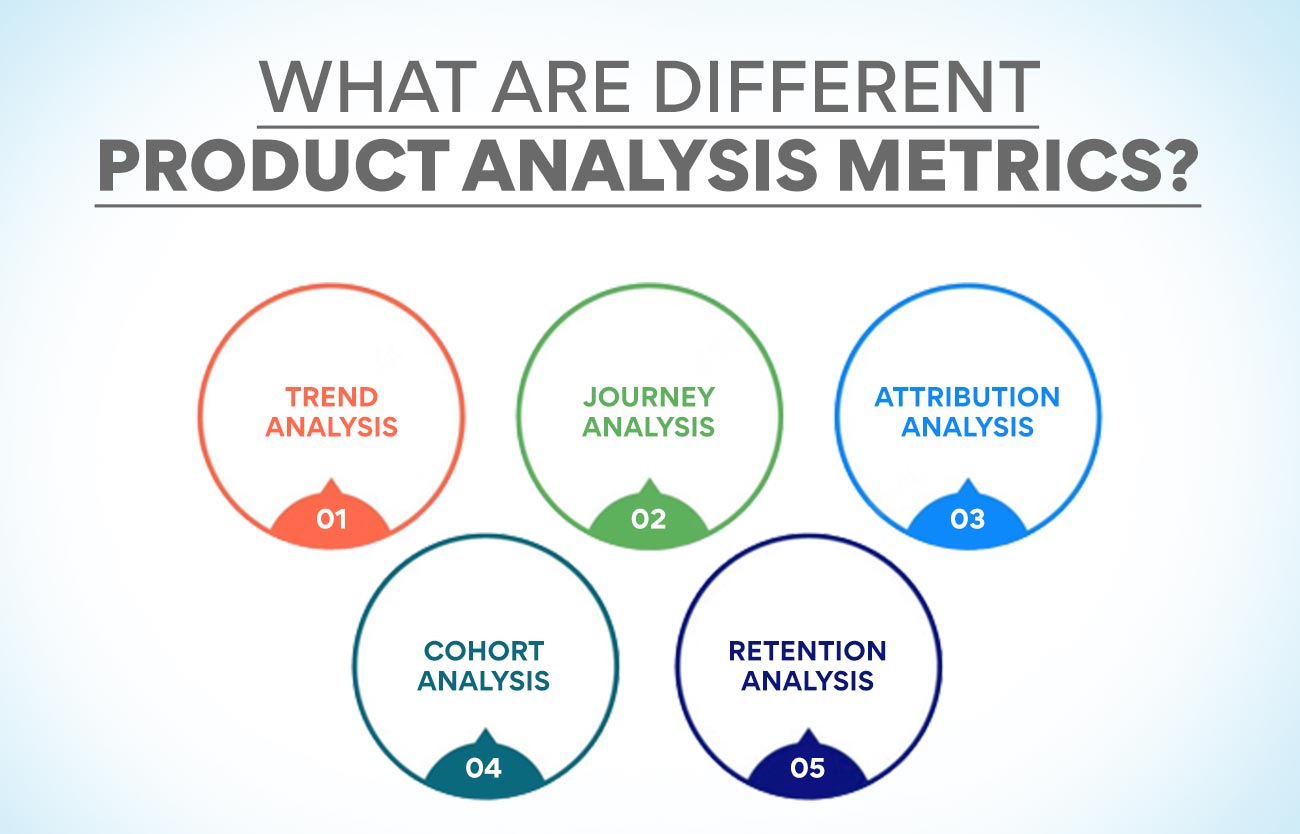Product analytics collects, analyses, and uses data to improve a product. It helps product managers and teams understand how their product is being used and identify areas for improvement. Product analytics can be used to track things like user engagement, conversion rates, and retention rates. It can also assess the impact of new features or design changes. This guide will discuss everything you want to know about product analytics. We will also discuss the types of data typically collected and analyzed as part of a product analytics initiative.
What Is Product Analysis?
Product analysis is the process of determining the suitability of a product for a given market. It involves specifying the product’s objectives, target market, and features. It also includes an evaluation of the competition and an analysis of customer needs and wants. After conducting a thorough analysis, businesses can determine whether or not to move forward with developing and marketing the product.
What is The Significance of Product Analysis?
Product analysis is the process of understanding a product’s potential and limitations. It allows businesses to identify opportunities for improvement and assess whether a product is meeting customer needs.
Product analysis can be conducted through market research, surveys, interviews, focus groups, and user testing. This data can help businesses improve their products and make informed decisions about future product development.
Product analysis can provide valuable insights that help businesses create better products and improve their bottom line when done properly.
What Are Different Product Analysis Metrics?
Trend Analysis
Product analytics helps you understand how customers communicate with your product and identify areas for improvement. There are several different product analysis metrics that you can track, including customer acquisition, engagement, retention, and churn.
Tracking these metrics allows you to identify customer behaviour trends and make product changes accordingly. For example, if you see that customer acquisition is trending downward, you may need to adjust your marketing strategy. Or, if engagement is trending upward, but retention is stagnant, you may need to focus on improving the user experience.
By constantly monitoring your product analytics, you can ensure that your product is always improving and meeting your customers’ needs.
Journey Analysis
Journey analysis is useful for product analysis because it gives you a bigger picture of how customers interact with your products. It can provide insights into customer behaviour, usage patterns, and preferences that traditional analytics might miss.
You can use journey analysis to uncover key moments or touchpoints in a user’s experience that need improvement and optimize the design of your product to maximize customer satisfaction. Additionally, journey analysis can help you understand how well certain features perform by tracking usage and engagement over time.
With journey analysis, you can identify areas of friction in the user experience that need to be addressed and measure the impact of changes on the customer experience. Finally, journey analysis can help you prioritize updates or design changes by offering insight into which features are the most popular and provide the greatest value to your customers.
Overall, journey analysis is a powerful tool for product analysis that can give you an in-depth view of how users interact with your products and make informed decisions about improvements or changes.
Also Read: What Are Product Management Courses? Why Are They Crucial?
Attribution Analysis
Product analytics helps you understand how your product is being used, so you can make informed decisions about improving it. You can use several different metrics to measure your product’s performance, and attribution analysis is one of them.
Attribution analysis is a way of understanding which features of your product are most important to users. By looking at how users interact with your product, you can identify which parts are most used and valued and make changes accordingly. This can be a valuable tool in deciding what to focus on when making improvements to your product.
There are a few different methods of attribution analysis, but one common approach is to look at how users interact with different parts of your product. For example, you might track how long users spend using each feature or how often they use each feature. By understanding which features are most used and valued by users, you can ensure that your improvements focus on the right areas.
Attribution analysis can be a valuable tool in helping you understand your product and make informed decisions about its future. By looking at how users interact with different parts of your product, you can identify which features are most important to them and make sure that your improvements focus on the right areas.
Cohort Analysis
Cohort analysis is a powerful tool for product analysts to measure and improve key product metrics. By understanding how different groups of users interact with your product, you can identify areas of improvement and optimize the user experience.
There are some things to consider when performing cohort analysis:
- Segment your users into groups based on similar characteristics. This could be based on the sign-up date, location, or any other relevant metric.
- Compare the behaviour of each group over time. It will help you identify trends and see how different cohorts interact with your product.
- Look at key product metrics such as engagement, retention, and conversion rates. It will give you insight into which areas need improvement.
- Use your findings to improve the user experience for all cohorts. It could involve changes to the product itself or targeted marketing campaigns
Retention Analysis
Retention analysis is a powerful tool for understanding how well your product works and identifying areas where you need to improve. By looking at retention, churn, and engagement rates, you can understand what’s working well and what needs improvement.
There are a few different ways to think about how retention analysis works as a product analysis metric. The most common way to measure retention is by looking at the percentage of users returning to your app or website within a certain period. This number can be useful in a couple of different ways.
First, it can help you understand how well your product works for its users. People use your product and find value in it if you have a high retention rate. They’re coming back because they want to use it again, which is a good sign.
On the other hand, the lower retention could indicate that people are not using your product as much as you’d like or that they’re not finding enough value in it to come back.
Second, retention rate can also help understand your acquisition efforts’ effectiveness. The acquisition is all about getting new users – but if those new users never come back, then it’s not doing much for you long-term. It could mean you need to work on better onboarding new users or giving them more reasons to come back. So if you’re seeing high acquisition but low retention rates, that’s something to take a closer look at.
There are different ways to calculate retention rate, but the most common is to look at the percentage of users who return within a certain period. For example, you might look at the percentage of users who return within 7 days, 30 days, or 90 days.
Another way to think about retention is through what’s called the “churn rate.” The churn rate is the opposite of the retention rate – it’s the percentage of users who stop using your product over a certain period. So if your retention rate is high, your churn rate is low. And vice versa – if your retention rate is low, your churn rate is high.
A churn rate can help you understand why your retention rate might be low. If you’re seeing high churn rates, that could indicate that people are leaving because they’re not finding enough value in your product. It could also be an indication that there’s something wrong with your product – maybe it’s buggy or hard to use – which is causing people to give up on it.
Finally, another way to think about retention is through what’s called engagement. Engagement is a measure of how often people are using your product. So if you have a high engagement rate, people are using your product a lot. And if you have a low engagement rate, people are using your product less.
Engagement can help you understand why your retention rate might be low. If you’re seeing low engagement rates, that could indicate that people are not finding enough value in your product to keep using it. It could also indicate that your product is too hard to use or that something else keeps people from using it as much as you’d like.
How Does Marketing Team Use Product Analysis?
Product analysis aims to help marketing teams make well-informed decisions about positioning and marketing their products. Product analysis is a process that the marketing team uses to understand a product’s market potential and its competition. Marketing teams use various analytical tools and techniques to study products, their prices, customer demand, and other essential factors.
There are several steps involved in product analysis. First, marketing teams must gather data about the product, its competitors, and the market. This data can be gathered from various sources, including market research reports, customer surveys, and social media platforms. Once the data is collected, it must be analyzed to identify trends and patterns. After the data has been analyzed, marketing teams can use it to develop strategies for positioning and marketing their products.
Product analysis is an essential tool for marketing teams because it helps them understand the market potential for their products. It also allows them to develop informed strategies for positioning and marketing their products. Product analysis can help marketing teams succeed in the marketplace when used correctly.
How does the Product Team Use Product Analysis?
Product teams use product analysis to understand how customers use their products, what features are most popular, and where there are opportunities for improvement. By analyzing data from customer usage, product teams can make informed decisions about which features to build next, how to improve the user experience, and where to focus their efforts.
Product analysis is essential for product teams who want to build great products that customers love. By understanding how customers use their products, product teams can make informed decisions about which features to build next, how to improve the user experience, and where to focus their efforts.
Step-By-Step Process For Product Analysis
Product analytics is the process of measuring and analyzing data about a product to improve its performance. Product analytics aims to help companies make better decisions about their products by understanding how customers use and interact with them.
There are several ways to collect data about a product, but the most common methods are through customer surveys, user testing, and data analysis of customer behaviour. Once data has been collected, it can be analyzed to identify trends and patterns. This information can then improve the product’s design, pricing, marketing, and overall strategy.
The following is a step-by-step guide for conducting product analytics:
- Define the goals of the analysis. What does the company want to learn about its product? What improvements does it hope to make?
- Collect data from various sources. This may include customer surveys, user testing, data analysis of customer behaviour, etc.
- Analyze the data to distinguish trends and patterns.
- Use the insights from the analysis to improve the product’s design, pricing, marketing, and/or overall strategy.
How To Implement Product Analysis?
Product analytics is collecting, analyzing and interpreting data about a product. Product analytics can be used to improve a product’s design, functionality and marketing.
There are many ways to implement product analytics. One way is to track customer behaviour. This can be done through surveys, interviews, focus groups or observation. Another way to implement product analytics is to track sales data. It can be used to understand what customers want and need from a product. Additionally, product analytics can be used to track competitor products. This information can be used to improve the design of your product.
Also Read: Project Manager Salary in India: 2023 Insights
What Are Different Product Analytics Tools And Methods?
Product analytics tools and methods help organizations understand how their products are performing and where they can improve. Many different types of product analytics tools and methods are available, each with its advantages and disadvantages.
Organizations must carefully select the product analytics tools and methods that best meet their needs. Some popular product analytics tools and methods include A/B testing, customer surveys, focus groups, interviews, usability testing, and web analytics.
Conclusion
Product analysis helps us understand our target market, competitors, and customer feedback. It translates raw data into actionable information that helps inform product design and development decisions. But it doesn’t stop there—it also allows us to understand consumer trends and make informed decisions about pricing strategies and marketing plans. If you’re pursuing a career in product analytics, this complete guide will give you everything you need to know to get started.
If you’re interested in learning more about product analysis, our Advanced Executive Certificate in Product Management is a perfect choice. This comprehensive program covers all the essential topics related to product analysis, including market research and pricing strategies. You’ll become an expert in analyzing customer needs and developing effective product plans. Plus, you’ll get a deep understanding of product life cycles and the different methods used to assess market trends.
More Information:
How To Become A Product Manager? A Complete Career Guide
Average Product Manager Salary In India






_1668670867.jpg)





















